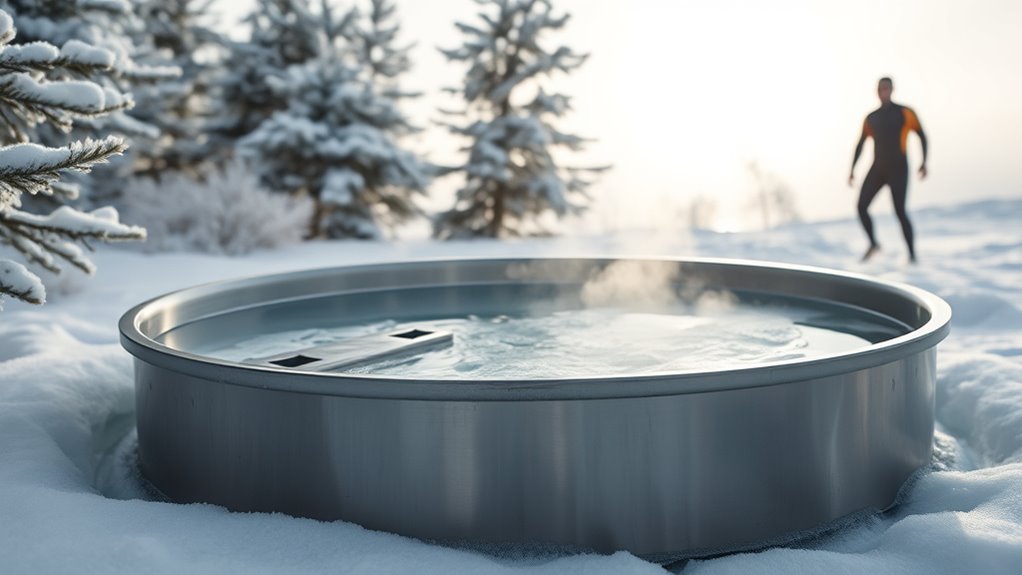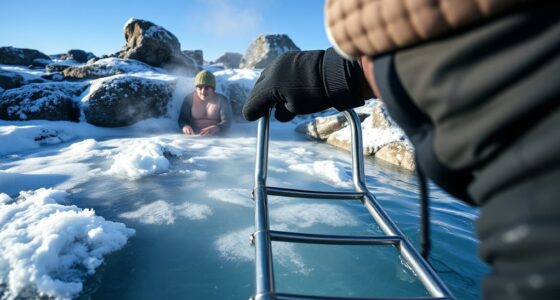Cold plunges can slightly increase your metabolism by activating brown fat and triggering shivering, but they’re not a quick fix for weight loss. While they boost calorie burn temporarily, the effects are modest and diminish over time as your body adapts. To see real results, focus on healthy eating and regular exercise first. If you want to explore how cold exposure can fit into your routine, keep going to uncover the full picture.
Key Takeaways
- Cold plunges can temporarily boost metabolism but are unlikely to cause significant weight loss alone.
- Activation of brown fat during cold exposure burns calories, but individual response varies.
- Cold therapy should complement, not replace, healthy diet and exercise for effective weight management.
- Prolonged or extreme cold exposure poses health risks; gradual, supervised cold plunges are safer.
- Sustainable weight loss relies on consistent healthy habits, with cold plunges serving as a supportive tool.

Many people are turning to cold plunge therapy as a potential aid for weight loss, believing that exposing their bodies to cold water can boost metabolism and burn calories. Cold exposure triggers a series of physiological responses that may influence your metabolic rate, which is the speed at which your body burns energy. When you immerse yourself in cold water, your body works harder to maintain its core temperature, activating mechanisms like shivering and increasing brown fat activity. This process can, in theory, raise your metabolic rate temporarily, leading to more calorie expenditure during and after cold exposure sessions.
Cold exposure boosts metabolism temporarily by activating shivering and brown fat activity.
However, it’s important to understand the extent of this effect. While cold exposure can indeed stimulate your metabolism, the increase is usually modest and short-lived. Your body adapts quickly, and the initial spike in calorie burn diminishes as you become accustomed to the cold. The idea that cold plunge therapy alone will lead to significant weight loss is a myth. It may complement other healthy habits, but relying solely on cold exposure won’t produce dramatic results.
Furthermore, the process of increasing your metabolic rate through cold exposure involves activating brown adipose tissue, or brown fat. Unlike white fat, which stores energy, brown fat burns calories to generate heat. When exposed to cold water, your brown fat becomes more active, contributing to a slight boost in calorie expenditure. Yet, the amount of brown fat you have and its responsiveness varies from person to person, making cold plunge therapy more effective for some and less for others.
You should also consider the practicality and safety of cold plunge therapy. While brief cold exposure can be beneficial for recovery and potentially for metabolic health, prolonged or extreme cold immersion can pose risks, especially if you have underlying health conditions. It’s essential to approach cold plunges cautiously, gradually increasing duration and coldness, and consulting a healthcare professional if needed.
Ultimately, cold exposure can influence your metabolic rate in the short term, but it doesn’t replace the foundational elements of weight loss—healthy eating and regular physical activity. Incorporating cold plunge therapy might provide some metabolic benefits, but it’s not a magic solution. Instead, view it as a supplementary tool that, when combined with a balanced lifestyle, can support your weight management goals. Remember, sustainable weight loss hinges on consistent habits, not quick fixes.
Frequently Asked Questions
Can Cold Plunges Replace Traditional Weight Loss Methods?
Cold plunges can’t replace traditional weight loss methods, but they can complement them. They may boost your metabolic effects temporarily and improve psychological benefits like mood and stress reduction. However, relying solely on cold plunges won’t lead to significant weight loss. To see real results, combine healthy eating, regular exercise, and lifestyle changes. Cold plunges can support your overall well-being but aren’t a substitute for proven weight management strategies.
How Often Should I Do Cold Plunges for Weight Management?
Picture yourself stepping into icy water, feeling the cold shock sharpen your focus and build mental resilience. You should aim for 2-3 cold plunge sessions per week, allowing your body time to recover and adapt. Consistency is key, but listen to your body’s signals. Regular cold plunges can enhance mental toughness and support weight management, but they shouldn’t replace balanced diet and exercise.
Are There Any Health Risks Associated With Cold Plunging?
You should be aware that cold plunging can pose health risks like cold shock, which causes rapid breathing and increased heart rate, and hypothermia if you stay in the water too long. To stay safe, limit your time in cold water and listen to your body. Always consult a healthcare professional before starting cold plunges, especially if you have heart or circulatory conditions.
Does Cold Exposure Improve Muscle Recovery Alongside Weight Loss?
Cold exposure can support muscle recovery through cold therapy, helping reduce inflammation and soreness after workouts. While it might not directly boost weight loss, combining cold therapy with your routine could improve muscle repair, making you feel ready sooner. You might notice that cold plunges, coincidentally, help you recover faster, so you stay consistent with exercise. Overall, cold exposure offers a beneficial way to aid muscle repair alongside your weight loss efforts.
What Is the Ideal Temperature for Effective Cold Plunges?
The ideal temperature for effective cold plunges is typically between 50°F and 59°F (10°C to 15°C). This range promotes cold adaptation and helps regulate your body’s temperature efficiently. You should aim for this temperature to maximize benefits like improved circulation and recovery. Always listen to your body, and gradually lower the temperature as you build tolerance to avoid shock or discomfort during your cold plunge sessions.
Conclusion
So, while cold plunges might seem like a quick fix for weight loss, the truth is more complex. They could support your goals in surprising ways, but they’re not magic bullets. The real question is, how much could this icy ritual really impact your journey? Will it become a game-changer or just a cool trend? Only time—and maybe a few more plunges—will tell. Are you ready to find out?









